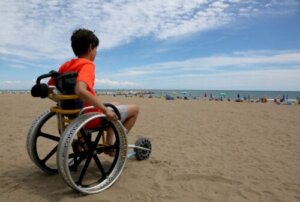Types of Muscular Dystrophy and Their Symptoms


Reviewed and approved by the nurse Leidy Mora Molina
The name muscular dystrophy is given to a very diverse group of hereditary diseases that cause weakness and degeneration in the muscles that control movement. There are more than 30 types of this pathology and all originate from genetic mutations.
Muscular dystrophy can affect the heart, the spine, the eyes, the brain, the endocrine glands, and other areas. Some forms of this disease are mild and progress gradually. Others evolve rapidly, create disabilities, and reduce life expectancy.
The symptoms of muscular dystrophy vary depending on the type of muscular dystrophy. In many cases, the disease is diagnosed during childhood, but it may also manifest itself in adolescence or adulthood.
What is muscular dystrophy?

Muscular dystrophy comprises a group of inherited disorders that cause weakness and loss of muscle tissue as they progress. Sometimes, this disease not only affects the muscle, but also organs such as the brain.
This pathology originates in genetic defects that produce a deficiency or defects in muscle protein. This leads to the muscle tissue degenerating and being replaced by fibrous tissues that can’t fulfill the function of a normal muscle.
The severity of the pathology varies greatly, depending on the type it corresponds to. In some cases, it can lead to the rupture of nerve tissue. It may also cause mild symptoms and cause no problems in leading a normal life.
Types and symptoms
All forms of muscular dystrophy cause weakness and some degree of atrophy in the muscles. However, it could be said that each type of this disease is unique, as the symptoms change, sometimes very noticeably. Let’s see the main types and their manifestations.
Duchenne muscular dystrophy (DMD)
Duchenne muscular dystrophy is one of the most common forms. It affects boys in particular, although it also occurs in girls, but less severely. It usually manifests itself between the ages of 1 and 3 years.
Boys with Duchenne muscular dystrophy have difficulty standing, walking, running, jumping, and climbing stairs. They’re also slow to develop speech and may have behavioral or learning difficulties. By the age of 12, they may be confined to a wheelchair.
You may be interested in: Fibromuscular Dysplasia: Diagnosis and Treatment
Becker muscular dystrophy
Becker muscular dystrophy affects mostly boys. Symptoms appear in childhood, but are usually mild. There may be only muscle cramps during exercise and a delay in learning to walk. Over time, there’s difficulty walking, running, and climbing stairs.
Sometimes there’s also difficulty lifting objects with a certain weight, above the waist. Most people with this pathology are usually able to walk until they’re 40 or 50 years old, but, at some point, they may need a wheelchair. There is a risk of developing cardiomyopathy or respiratory problems.
Congenital
Congenital muscular dystrophy manifests itself from birth or in the first two years of life. The progression, as well as the severity of the disease, varies greatly from one case to another.
The usual symptoms are the following:
- Joint problems
- Scoliosis
- Breathing difficulties
- Swallowing problems
- Seizures
- Vision problems
- Speech difficulties
- Intellectual disability with different levels of severity
Myotonic
Myotonic muscular dystrophy usually first affects the smaller muscles, such as those of the face, neck, and jaw. It often progresses slowly, but tends to become more severe later on. It can appear at any time in life.
Symptoms include muscle weakness, stiffness, drowsiness or excessive sleepiness, cardiac arrhythmia, lens opacity or cataracts, and behavioral and learning problems in children. The earlier the symptoms appear, the shorter the patient’s life expectancy and the greater the likelihood of disability.
You might also be interested in: Neuromuscular Disorders: Signs and Symptoms
Facioscapulohumeral
Facioscapulohumeral muscular dystrophy usually occurs without symptoms well into adulthood, but sometimes manifests in childhood. It affects slightly more males than females. It tends to progress slowly and sometimes affects only one side of the body. One in ten people affected will eventually need a wheelchair.
In children, one of the first symptoms is a tendency to sleep with their eyes slightly open. They also show an inability to close their eyes, squeezing them shut and pursing their lips. In adolescents and adults, there’s pain in the shoulders, thin arms, and weakness in the muscles of the face, upper arms, upper back, and calves.
Limb-girdle muscular dystrophy
Limb-girdle muscular dystrophy affects the muscles of the arms around the shoulders and the muscles in the legs around the hips. The first symptoms usually appear in late childhood or early adulthood.
The progression can be slow or rapid. The most common symptoms of this condition are as follows:
- Muscle weakness in the arms, thighs, and hips
- Loss of muscle mass in the affected areas
- Palpitations
- Irregular heartbeat
- Back pain
- Difficulty lifting heavy objects
- Problems running or standing up from a low chair
Emery-Dreifuss
Emery-Dreifuss muscular dystrophy often manifests in childhood or adolescence. Shortened life expectancy is common. It mainly affects the arms, neck, and feet. Most commonly, at the beginning of the disease, there are muscle contractures in these areas.
As the disease progresses, it becomes more difficult to bend the neck forward, straighten the elbows, and the upper arms and lower legs weaken. Later, the thighs and hips are affected. Eventually, sufferers will have to use a wheelchair.
Oculopharyngeal

Oculopharyngeal muscular dystrophy usually develops around the age of 50. It causes problems in the eye and throat muscles. If treatment is carried out, this modality doesn’t affect a person’s life expectancy.
The main symptom is usually drooping eyelids; in some cases, this makes vision difficult or leads to the development of double vision. Another characteristic manifestation is difficulty swallowing food. This may lead to chest infections. There’s often weakness in the shoulders and hips.
Distal
Distal muscular dystrophy progresses more slowly than other forms of this disease. It usually manifests for the first time between 40 and 60 years of age. It affects the muscles of the hands, feet, and lower arms and legs. It’s one of the less severe types.
There’s no cure for dystrophy, but it is possible to alleviate the symptoms
There’s no cure for the different types of muscular dystrophy. Treatment is aimed only at controlling symptoms, avoiding complications, and keeping the affected person as functional as possible for as long as possible.
All types of muscular dystrophy worsen over time, but what changes is the speed at which this happens and the level of disability it generates. There are support groups to welcome and help people with this disorder.
All cited sources were thoroughly reviewed by our team to ensure their quality, reliability, currency, and validity. The bibliography of this article was considered reliable and of academic or scientific accuracy.
- Chaustre, D. M., & Chona, W. (2011). DISTROFIA MUSCULAR DE DUCHENNE: PERSPECTIVAS DESDE LA REHABILITACIÓN. Revista Med, 19(1), 37-44.
- Sánchez, A. I., Mariño, N., Araujo, A. F., & Espinosa, E. (2019). Distrofia muscular de Becker con duplicación en el exón 5del gen DMD. Revista Repertorio de Medicina y Cirugía, 28(2).
- Santos, G. M., Lemus, A. M., Alfaro, R. R., & Ventura, M. D. L. S. (2017). Distrofia muscular progresiva. Revista del Hospital Juárez de México, 69(1), 30-37.
This text is provided for informational purposes only and does not replace consultation with a professional. If in doubt, consult your specialist.








